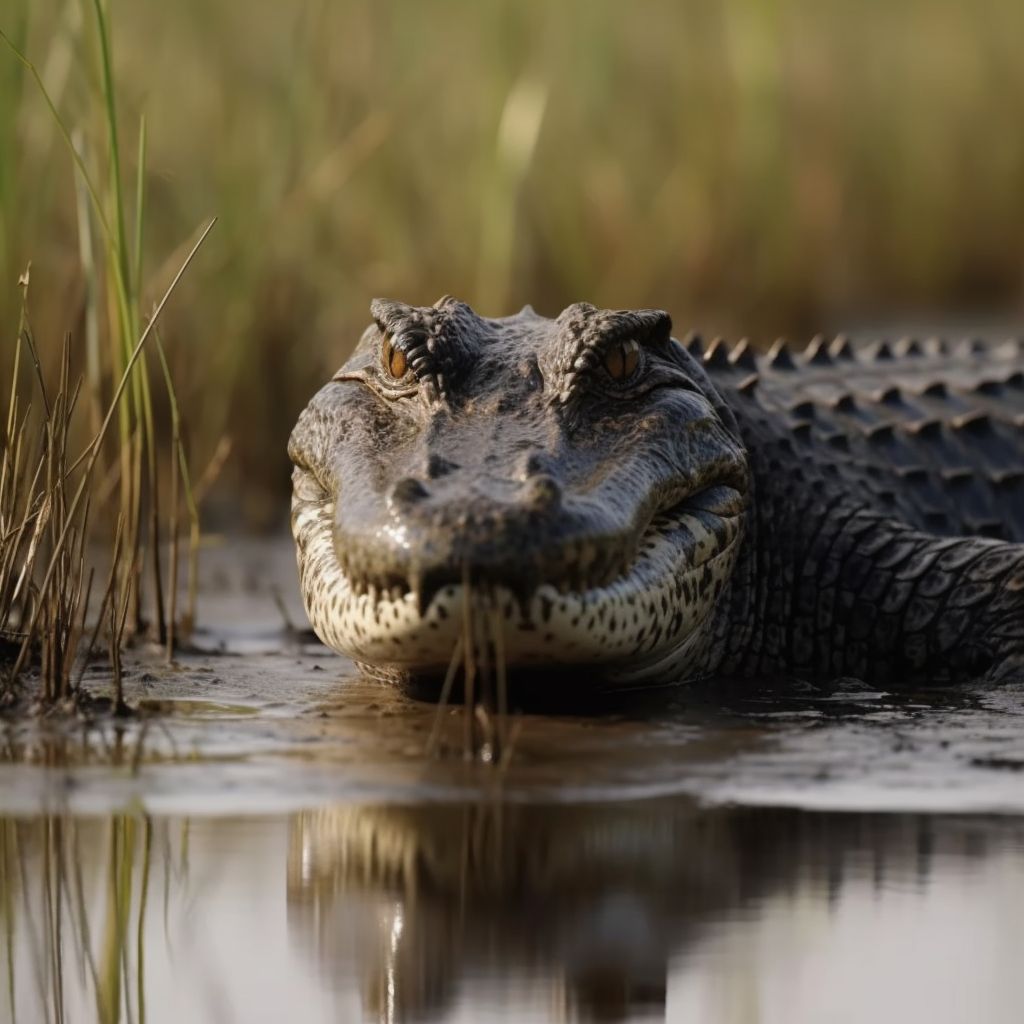Alligator
Alligators are large, semi-aquatic reptiles native to the United States, primarily found in the southeastern regions. There are two species of alligators in the US: the American alligator (Alligator mississippiensis) and the rare and lesser-known Chinese alligator (Alligator sinensis), which has been introduced through Human intervention. These formidable creatures have been a source of fascination and fear for generations, inspiring countless tales and legends. In the late 19th century, alligators were increasingly sought after for their hides and meat, as well as for their role in the burgeoning entertainment industry.
Description and Distribution
The American alligator is a large reptile that can reach lengths of up to 15 feet and weigh up to 1,000 pounds. Males are generally larger than females. They have a powerful, streamlined body with thick, armored skin that provides protection from predators and environmental hazards. The color of their skin ranges from dark green to nearly black, with a lighter, cream-colored underside.
Alligators have a broad, rounded snout and a powerful jaw filled with sharp, conical teeth. Their eyes and nostrils are positioned on top of their head, allowing them to see and breathe while mostly submerged in water. They are strong swimmers and can move quickly on land over short distances.
The American alligator is native to the southeastern United States, with a range that extends from the southern tip of Texas to the coastal regions of North Carolina. They inhabit a variety of freshwater habitats, including swamps, marshes, rivers, and lakes.
Behavior and Diet
Alligators are carnivorous reptiles with a diet that includes fish, birds, mammals, and other reptiles. They are ambush predators, using their stealth and camouflage to lie in wait for unsuspecting prey. Alligators are known to be opportunistic feeders, consuming carrion when it is available.
These reptiles are primarily nocturnal, hunting and feeding during the night. They spend much of their day basking in the sun to regulate their body temperature, as they are ectothermic and rely on external heat sources for thermoregulation.
Reproduction and Life Cycle
Alligators typically mate in the spring, with females laying their eggs in a nest made of vegetation and mud. The nest serves to incubate the eggs, with the decomposing vegetation generating heat. The female alligator guards the nest fiercely, protecting her eggs from potential predators.
After about 65 days, the eggs hatch, and the mother helps the hatchlings to the water. Alligator hatchlings are vulnerable to predation and have a high mortality rate. Those that survive can live for several decades in the wild, with some individuals reaching ages of 50 years or more.
Economic and Cultural Significance
In the late 19th century, alligators were increasingly hunted for their hides, which were used to make high-quality leather goods, such as boots, belts, and bags. The meat was also consumed, considered a delicacy in certain regions. This demand for alligator products led to a decline in their populations, prompting concerns about the long-term survival of the species.
Alligators also played a significant role in the entertainment industry of the time. They were featured in sideshows and traveling exhibitions, often billed as "man-eaters" or "monsters of the deep." Alligator wrestling, a dangerous and thrilling spectacle, gained popularity during this period, with daring individuals showcasing their skill and bravery by grappling with the powerful reptiles.
Conservation
In response to the decline in alligator populations due to overhunting, efforts were made to protect the species and ensure its survival. This included the establishment of wildlife refuges, hunting restrictions, and public education campaigns to raise awareness about the importance of alligators in their ecosystems. These efforts aimed to strike a balance between the economic benefits derived from alligator products and the need to maintain healthy, sustainable populations of these remarkable reptiles.
Scientific Study and Alligator-based Innovations
In addition to their cultural and economic significance, alligators were also the subject of scientific study during this period. Researchers sought to better understand their physiology, behavior, and ecological role, as well as to uncover the secrets of their remarkable ability to survive and thrive in their often harsh environments.
This interest in alligators led to several innovations and discoveries, some of which had applications beyond the realm of biology. For example, the study of alligator skin and its natural armor inspired the development of new materials and protective gear, while insights into the reptiles' powerful immune system and wound-healing abilities spurred research into potential medical applications.
Alligators and Folklore
Throughout the southeastern United States, alligators have long been a part of local folklore and mythology. They have been both feared and revered, with tales of their ferocity and cunning passed down through generations. Some stories attribute mystical powers to these creatures, while others emphasize their role as guardians of the waterways and protectors of their habitats.
In some communities, alligators were seen as symbols of strength and resilience, while in others, they served as cautionary figures, warning of the dangers that lurked in the swamps and marshes. The enduring fascination with these ancient reptiles can be seen in the many legends, stories, and artworks that continue to captivate the imagination of people in the United States and beyond.
Conclusion
Alligators are fascinating creatures that play an important role in the culture, economy, and ecology of their native regions. Their unique characteristics inspired scientific study, technological innovations, and countless tales of mystery and wonder. As human populations expanded and the demand for alligator products increased, efforts were made to protect these remarkable reptiles and ensure their continued survival.

